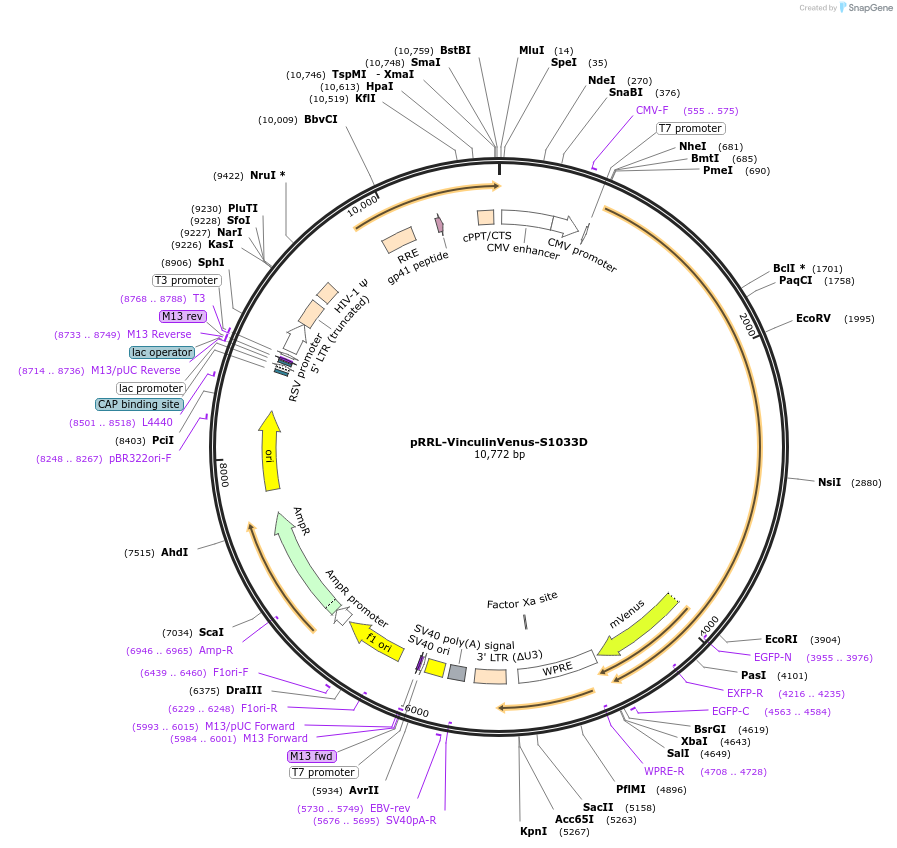pRRL-VinculinVenus-S1033D
(Plasmid
#211897)
-
PurposeVinculin (chicken) with S1033 phosphomimetic point mutation (S1033D) tagged with VenusA206K at the C-terminus, in lentiviral expression vector.
-
Depositing Lab
-
Sequence Information
Ordering
| Item | Catalog # | Description | Quantity | Price (USD) | |
|---|---|---|---|---|---|
| Plasmid | 211897 | Standard format: Plasmid sent in bacteria as agar stab | 1 | $89 | |
Backbone
-
Vector backbonepRRL
- Backbone size w/o insert (bp) 6129
- Total vector size (bp) 10778
-
Vector typeLentiviral
Growth in Bacteria
-
Bacterial Resistance(s)Ampicillin, 100 μg/mL
-
Growth Temperature30°C
-
Growth Strain(s)NEB Stable
-
Copy numberUnknown
Gene/Insert
-
Gene/Insert nameVinculinVenus-S1033D
-
Alt nameVinV-S1033D
-
SpeciesG. gallus (chicken)
-
Insert Size (bp)4649
-
Mutationmutated vinculin serine 1033 to aspartic acid (S1033D), creates phosphomimetic mutant
-
Entrez GeneVCL (a.k.a. VINC1)
- Promoter CMV
-
Tag
/ Fusion Protein
- VenusA206K (C terminal on insert)
Cloning Information
- Cloning method Restriction Enzyme
- 5′ cloning site EcoRV (destroyed during cloning)
- 3′ cloning site XbaI (not destroyed)
- 5′ sequencing primer GGTACAGTGCAGGGGAAAG
- 3′ sequencing primer GTTAAGAATACCAGTCAATCTTTCAC
- (Common Sequencing Primers)
Resource Information
-
Supplemental Documents
-
A portion of this plasmid was derived from a plasmid made byMartin Schwartz (Addgene #27300)
Terms and Licenses
-
Academic/Nonprofit Terms
-
Industry Terms
- Not Available to Industry
Trademarks:
- Zeocin® is an InvivoGen trademark.
These plasmids were created by your colleagues. Please acknowledge the Principal Investigator, cite the article in which the plasmids were described, and include Addgene in the Materials and Methods of your future publications.
-
For your Materials & Methods section:
pRRL-VinculinVenus-S1033D was a gift from Brenton Hoffman (Addgene plasmid # 211897 ; http://n2t.net/addgene:211897 ; RRID:Addgene_211897) -
For your References section:
Coupling during collective cell migration is controlled by a vinculin mechanochemical switch. Shoyer TC, Gates EM, Cabe JI, Urs AN, Conway DE, Hoffman BD. Proc Natl Acad Sci U S A. 2023 Dec 12;120(50):e2316456120. doi: 10.1073/pnas.2316456120. Epub 2023 Dec 6. 10.1073/pnas.2316456120 PubMed 38055737



